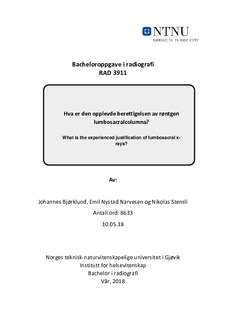| dc.contributor.advisor | Gransjøen, Ann Mari | |
| dc.contributor.author | Bjørklund, Johannes | |
| dc.contributor.author | Narvesen, Emil Nystad | |
| dc.contributor.author | Stensli, Nikolas | |
| dc.date.accessioned | 2018-08-23T07:30:42Z | |
| dc.date.available | 2018-08-23T07:30:42Z | |
| dc.date.issued | 2018 | |
| dc.identifier.uri | http://hdl.handle.net/11250/2558935 | |
| dc.description.abstract | Problemstilling: Hva er den opplevde berettigelsen av røntgen LS blant radiografer og radiologer? Formål: Formålet med studien er å se på hvordan radiografer og radiologer vurderer røntgen LS som utredningsverktøy av lower back pain i forhold til dens berettigelse. Metode: Kvalitative intervjuer ble brukt sammen med innhentet tidligere forskning. Fire deltakere ble intervjuet på offentlig sykehus og privat røntgeninstitutt. Resultat: Deltakerne opplever at røntgen LS er nyttig for å utelukke alvorlige tilstander, men er lite sensitiv i forhold til lower back pain. Henviseres vurdering og ressursmangel på MR blir oppgitt som årsaker for at røntgen LS gjøres på tross av at det bryter med nasjonale retningslinjer. Konklusjon: Den opplevde berettigelsen av røntgen LS er god, der spesifikk mistanke om patologi foreligger. Berettigelsen er derimot ikke tilstrekkelig der man vil utrede lower back pain. Resultatene tyder på at med bedre oppfølging av retningslinjer, kan den diagnostiske nytteverdien stige. | nb_NO |
| dc.description.abstract | Topic/research question: How do radiographers and radiologists experience the justification of lumbosacral x-ray imaging? Purpose: The purpose of the study is to examine how radiographers and radiologists consider x-ray of lumbosacral as an investigative tool in lower back pain cases and if it is justified. Method: Qualitative interviews was used together with earlier research on the subject. There were four participants included in the study, who worked either at a public hospital or a private institute. Results: The participants experienced that lumbosacral x-ray is useful to exlude severe conditions but is not an optimal diagnostic tool in patients with lower back pain. The referring doctors’ assessment of the patient, and lack of MRI resources, was explained as primary causes for why x-ray of lumbosacral spine is done, even though it is not recommended in the national guidelines. Conclusion: The experienced justification of lumbosacral x-ray where there is specific suspicion of pathology, is high. In cases of lower back pain where there is not enough evidence of pathology, the justification for lumbosacral x-ray is not sufficient. The results indicate that the diagnostic value may increase with more thorough follow-up in relations to the national guidelines. | nb_NO |
| dc.language.iso | nob | nb_NO |
| dc.subject | radiografi | nb_NO |
| dc.subject | røntgen | nb_NO |
| dc.subject | lumbosacral | nb_NO |
| dc.title | Hva er den opplevde berettigelsen av røntgen lumbosacralcolumna? | nb_NO |
| dc.title.alternative | What is the experienced justification of lumbosacral x-rays? | nb_NO |
| dc.type | Bachelor thesis | nb_NO |
| dc.subject.nsi | VDP::Medical disciplines: 700::Clinical medical disciplines: 750::Radiology and diagnostic imaging: 763 | nb_NO |
| dc.source.pagenumber | 40 | nb_NO |
